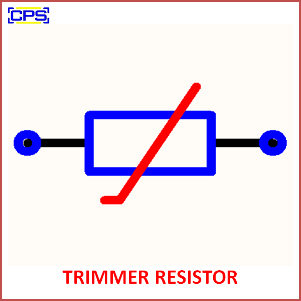A Trimmer Resistor is a small, adjustable resistor used to fine-tune or calibrate the resistance in a circuit. Unlike regular resistors, which have fixed resistance values, a trimmer resistor allows users to vary its resistance to specific values within a certain range. These are commonly used for precision adjustments in circuits where minor changes in resistance are required.

Key Features of a Trimmer Resistor:
- Adjustability:
- Typically equipped with a small screw or dial that allows the user to change its resistance manually.
- Size:
- Small in size and often used in compact electronic devices where space is limited.
- Types:
- Preset Trimmers: Usually adjusted once during the assembly or calibration process and left unchanged.
- Multi-turn Trimmers: Allows finer adjustments by rotating the screw multiple times for more precise control over the resistance.
- Construction:
- Made with a resistive element (often a ceramic or carbon-based material) and a wiper that moves to change the resistance.
Working Principle:
- A trimmer resistor operates on the same principle as a standard resistor: by offering a certain resistance to the flow of current.
- The adjustment mechanism (a screw or dial) moves the wiper across a resistive element, altering the resistance. The change in resistance allows for fine-tuning of circuits such as voltage dividers or feedback loops.
Applications of Trimmer Resistors:
- Calibration:
- Commonly used in devices that require precise calibration, such as oscillators, amplifiers, and audio equipment.
- Circuit Tuning:
- Used to adjust the behavior of electronic circuits for optimal performance, such as in tuning radios or other communication devices.
- Adjusting Gain or Sensitivity:
- Often used in sensor circuits or audio amplifiers to adjust gain or sensitivity levels.
- Voltage Regulation:
- Employed in power supplies and voltage regulators to set precise output voltages.
Advantages:
- Fine Adjustment: Allows for precise tuning of circuit parameters.
- Small and Compact: Ideal for applications where space is limited.
- Easy to Use: Simple to adjust with a small screwdriver or dial.
Disadvantages:
- Limited Adjustments: Can only be adjusted within a specific range and may not provide continuous adjustment.
- Mechanical Wear: The adjustment mechanism may wear out over time, especially if frequently adjusted.
- Relatively Low Power Handling: Not suitable for high-power applications.
